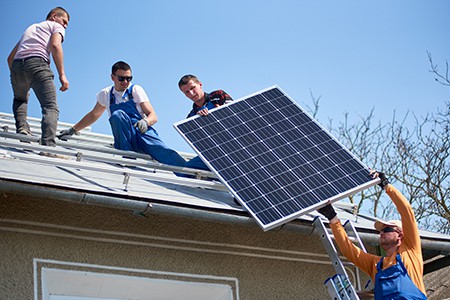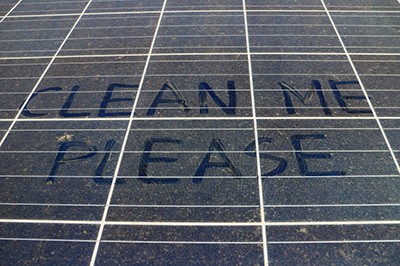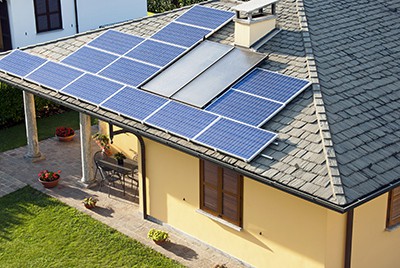Wondering: What are the best batteries for home solar?

Solar energy systems make sense, and you can install them with or without PV battery systems for storing power.
If you already have a grid-tie system and are thinking about adding a sun power battery, or, if you are new to rechargeable solar battery systems, you might be confused about solar battery options, storage battery systems, solar battery life, and battery energy efficiency.
If so, read on for detailed information about solar battery options and what you need to know when adding a rechargeable solar battery to existing solar panels.
The Basics of a Sun Power Battery
You can install a solar power system on your home without using batteries and let the power storage companies store your surplus energy for you. That said, there are some good reasons for using a solar replacement battery and having complete control over the power you need.

Reasons to Use Solar Battery Storage:
- If the power grid goes out, PV battery systems give you the best power backup to keep electricity flowing in your home.
- In off-grid locations, storage battery systems are the only option if you want power when the sun isn’t shining.
- Reliable batteries give you the maximum control over the solar-generated power in your home without relying on power storage companies to provide you with electricity.
When solar power was a new technology 30 years ago, 12 volt systems were standard: the same batteries used in cars, boats, and RVs and mini solar battery applications. The problem is, most appliances do not work on 12 volts.
Currently, solar technology is much more advanced, and you can easily generate 120 volts with a solar inverter and state-of-the-art batteries for storage of energy. But before you invest in a sun-powered battery set-up, you need to understand how these batteries are rated.
The primary information you need about a battery for solar power are:
- Capacity
- Power rating
- Depth of Discharge, or DoD
- Round-trip efficiency
Let’s go into each of these in detail.
Capacity
Capacity refers to the total amount of power a storage cell is capable of holding in kilowatt hours (kWh). You can hook multiple batteries together in series and achieve more capacity.
Power Rating
Power rating refers to how much of the stored energy the battery can provide at any given time. One way to visualize these two battery features is to think of it like a tub of water with a spigot. Capacity is how large the container is, and power rating is how big the faucet is.
If a battery has a high capacity but low power rating, just like the tub of water, a small amount can be taken out over a more extended period. Conversely, if the capacity is low, but the power rating is high, you can use more appliances at one time but for a shorter amount of time.
DoD (Depth of Discharge)
DoD tells you how low you can drain the battery before you damage it. You cannot completely drain solar battery systems without compromising the life of the battery. DoD is measured by the percent of kWh you can use before you reach the limit for that battery. Higher DoD batteries can be drained more completely than lower DoD batteries.
Round-trip Efficiency
Round-trip efficiency tells you about battery energy efficiency and how much energy the battery uses on its own as it charges and recharges. Batteries with higher round-trip efficiency have higher total battery energy efficiency.
Solar Battery Options

Which battery type is best for your situation depends in part on what type, and how many, solar panels you have. If you have a small array of round solar panels for powering an automatic gate opener, you will need a different type of battery than you would need for a 10,000-watt solar panel array for powering a large house.
There are several basic types of solar batteries to consider when deciding on the best power backup for your situation.
The main types of battery now on the market include:

Flooded lead-acid batteries, or wet cell
These are similar to a battery used in a car. The most significant advantages of this battery are reliability and cost. The most significant disadvantages are that they are heavy, prone to corrosion, need adequate ventilation, and require the most solar battery maintenance but these batteries are often the best if you have small, round solar panels for a 12-volt power source.

Absorbent Glass Mat (AGM)
These are similar to flooded lead-acid batteries but are built with a fiberglass mat which absorbs the electrolyte. AGM batteries work better in higher temperatures and have a slow discharge rate. Unlike lead-acid types, these batteries are sealed and do not leak or need as much ventilation. AGM batteries are also lighter in weight than lead-acid batteries.
TIP: Both flooded lead-acid batteries and AGM batteries are the top choices for off-grid locations.

Solar Gel Batteries
This battery type uses the mineral silica mixed with another chemical as the electrolyte, forming a thick substance which cannot leak out and does not need ventilation.
Solar gel batteries discharge slowly, but they have a couple of disadvantages, such as being easily damaged by overcharging. They are also more expensive than many other types of battery for solar applications. On the plus side, this battery type withstands high amounts of vibration, higher temperature conditions, and require little maintenance.

Lithium-ion Batteries
Many people are familiar with lithium-ion batteries because they have used them in cordless tools. They have high charging efficiency, long solar battery life, and are much lighter in weight than many other types of battery. Duracell solar batteries used for landscape lighting are one popular type of mini solar array using lithium technology.
One type of lithium battery now in the top 10 batteries for solar applications are the Lithium-iron phosphate or LiFePO4 batteries. These are the smallest, lightest, and safest batteries with the longest life span – up to 20 years. They also have the best discharge efficiency, making them especially useful in applications where the system is not in continuous use.
The biggest downside of lithium batteries is the price tag, costing as much as four times as much as other storage cell systems. But, lithium batteries are one of the most reliable batteries available.
Solar Battery Maintenance
The type of maintenance required for a solar battery depends on the battery type.

Flooded lead-acid batteries contain a liquid electrolyte and are the most prone to corrosion and require the most maintenance. Using a sealant like petroleum jelly on all terminals significantly reduces corrosion.
Washing the top of batteries helps remove dust which can lead to a small amount of energy loss between the terminals. Be sure to locate the batteries where you can easily wash them.
Batteries deteriorate more quickly when the temperature fluctuates to extremes. The best place for solar batteries is an insulated location where the temperature stays as close as possible to 77ºF (25ºC).
You can also reduce the need for solar battery maintenance by installing more batteries in series and increasing the overall capacity of your system.
The Best Solar Batteries for Your Home

Solar replacement battery systems come in many shapes and sizes from small Duracell solar batteries for charging a mini solar battery for outdoor landscaping to medium-sized flooded lead-acid batteries ideal for off-grid locations to large lithium batteries for powering a big house with high energy needs.
Which of the top 10 batteries are best for your home depends on your specific electrical needs, how willing you are to do maintenance on batteries, and your budget for upgrading your solar energy system.